The Earliest Sharks
Tracing the evolution of sharks is frustrated by the nature of the beast. Due to their characteristic cartilaginous skeleton, ancient sharks have left behind precious few clues to enable us to figure out what they were like. Which is not to say that we have little shark fossil material. We have thousands of fossil shark scales (which are probably the most abundant of vertebrate microfossils, but often overlooked because of their tiny size), hundreds of fin spines, the occasional vertebra or cranium, and - very exceptionally - impressions of soft tissues. But, because they are mineralogically stable and shed throughout a shark's lifetime, mostly we have teeth - thousands upon thousands of fossilized shark teeth sparkling in an enormous void of geologic time.
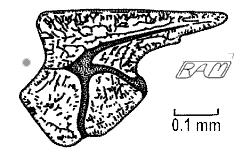
Scale of Elegestolepis |
The earliest sharks are represented by a mere handful of isolated scales. Shark scales have a characteristic tooth-like structure, so we can be reasonably confident that such scales did, in fact, come from some kind of shark. The oldest shark-like scales date back to the late Ordovician Period, about 455 million years ago, from what is now Colorado. These scales, however, differ from those of modern sharks in several important respects, so not all paleontologists agree that they came from true sharks. The oldest undisputed shark scales are about 420 million years old, from early Silurian deposits in Siberia. These diminutive survivors of prehistory have been assigned to the genus Elegestolepis, but we have no clues about what the rest of the shark might have looked like. Shark-like scales of similar age are also known from what is now Mongolia, and have been assigned to the genera Mongolepis and Polymerolepis. Other than having names for these earliest sharks, we know almost nothing about them.
Fortunately, the shark fossil record becomes richer and more varied from the Devonian Period onward. The earliest fossil shark teeth are from early Devonian deposits, about 400 million years old, in what is now Europe. These teeth are two-pronged and puny, less than an eighth of an inch (3-4 millimetres) in length. They belonged to a mysterious ancient shark known as Leonodus. Based on its double-cusped teeth, Leonodus may have belonged to a family of freshwater sharks known as the xenacanths. But not all paleontologists agree on this interpretation. Thus, like most of the earliest sharks, Leonodus is a name without a face.
|
Early Fossil Shark Teeth The earliest known fossil shark teeth are those of Leonodus (left) dating back some 400 million years. Their overall crown shape vaguely resembles that of fossilized Xenacanthus teeth (right), possibly indicating that these early sharks were related. Their roots, however, are quite different, suggesting that Leonodus and Xenacanthus may have evolved similar crowns as an adaptation to feeding on similar prey rather than due to shared ancestry. |
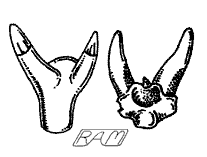 |
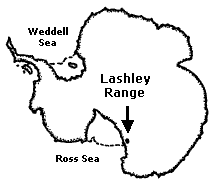 |
Location of the oldest known articulated fossil shark remains, some 380 million years old. Since many of the earliest fossil shark remains are from Antarctica and Australia, paleontologist John Long has suggested that sharks may have originated in the Southern Hemisphere. |
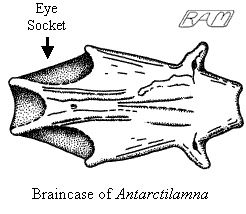 The oldest
fossilized shark braincase is from mid-Devonian deposits about 380 million
years old, in what is now New South Wales, Australia. Based on the form of
this nearly complete braincase, many paleontologists believe that its former
owner may have been a xenacanth. The oldest partially articulated fossilized
shark remains were discovered by geologist Gavin Young in deposits of about
the same age in the Lashley Range of Antarctica. Although they display an
odd combination of features, these remains may also have been from a
xenacanth - possibly the same species as produced the oldest fossil shark
braincase. Young named this 16-inch (40-centimetre) shark Antarctilamna,
meaning "lamnid shark from Antarctica". Impressions of braincases,
fin spines, and teeth from this early shark are known from Australia and
Saudi Arabia.
The oldest
fossilized shark braincase is from mid-Devonian deposits about 380 million
years old, in what is now New South Wales, Australia. Based on the form of
this nearly complete braincase, many paleontologists believe that its former
owner may have been a xenacanth. The oldest partially articulated fossilized
shark remains were discovered by geologist Gavin Young in deposits of about
the same age in the Lashley Range of Antarctica. Although they display an
odd combination of features, these remains may also have been from a
xenacanth - possibly the same species as produced the oldest fossil shark
braincase. Young named this 16-inch (40-centimetre) shark Antarctilamna,
meaning "lamnid shark from Antarctica". Impressions of braincases,
fin spines, and teeth from this early shark are known from Australia and
Saudi Arabia.
What Was Antarctilamna Like?
Despite all these fossilized Antarctilamna bits and pieces, paleontologists have had a difficult time puzzling out what the whole animal was like in life. Antarctilamna had a stout spine in front of the long, low dorsal fin and two-pronged teeth (a tooth type termed "diplodont"), a combination which immediately suggests xenacanth affinities.
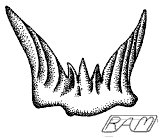 Antarctilamna tooth showing the xenacanth-like two pronged crown |
Xenacanths were almost exclusively freshwater inhabitants, and had a long, rearward-pointing fin spine just behind the cranium (the name xenacanth means "strange spine"), diplodont teeth, a slender, eel-like body, an elongate dorsal fin extending along most of the back, and a symmetrical, tapering tail. If Antarctilamna was a xenacanth, it probably had the same type of body form and tail, which may have allowed it to swim among dense lake vegetation. Thus far, Antarctilamna is known only from freshwater deposits, therefore - whatever its body form - it seems likely that it led a xenacanth-like lifestyle, haunting freshwater lakes and rivers. But Antarctilamna also had some very unxenacanth-like features. In particular, its fin spines more closely resemble those of another group of ancient sharks known as the ctenacanths. In both Antarctilamna and the ctenacanths, the fin spines are cylindrical and ornamented with unique rows of small thorn-like denticles (the name ctenacanth means "comb spine"). The ctenacanths were more typically shark-shaped than the eel-like xenacanths, with a solidly-built, tapered body, two separate dorsal fins, and a deeply-forked tail. Yet ctenacanths are also characterized by having multi-cusped teeth (a tooth type termed cladodont, meaning "branch-toothed"), which are very unlike those of Antarctilamna and the xenacanths. Current paleontological consensus tentatively classifies Antarctilamna as a xenacanth, but it is still not settled whether it was a xenacanth with ctenacanth-like fin spines, a ctenacanth with xenacanth-like teeth, or something else altogether.
|
Reconstruction of Xenacanthus, an eel-shaped shark that haunted freshwater habitats in what is now Europe during the early Permian (about 280 million years ago). Could Antarctilamna, which lived about 100 million years earlier. have looked like this? A 1995 paper by John Long and Gavin Young proposed that Antarctilamna was a 'stem-group xenacanth', evolutionarily rather removed from Xenacanthus and other 'crown-group xenacanths'. Time and further specimens may eventually support or refute this idea. |
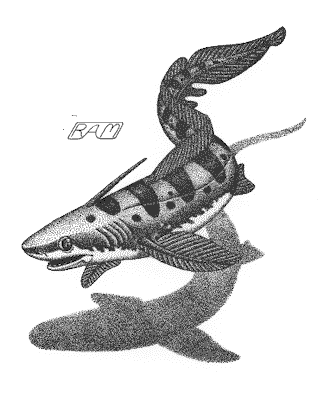 |
Despite these uncertainties about the interrelationships, form and lifestyle of Antarctilamna, there is no doubt that it was a full-fledged, card-carrying shark - making it among the very earliest verified ancestors of modern sharks. Thus, sharks were already a distinct lifeform by the middle Devonian Period, more than 400 million years ago.
The world was a very different place back then. There were only two continents, Laurasia in the north and Gondwanaland in the south. These landmasses were surrounded by warm, shallow seas.* If you were to travel back in time 400 million years, you would find a veritable bestiary of strange and bizarre creatures. Life thrived in the Devonian seas.
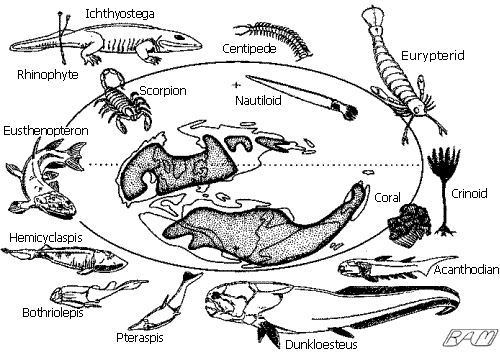
The Devonian World
Giant eurypterid 'sea scorpions' pursued early jawed fishes, including acanthodians (sometimes called 'spiny sharks', though not related to true sharks) and shield-headed fishes called placoderms (which probably shared a common ancestor with the sharks). Rugose and halysite corals built great reefs, providing food and living spaces for many different kinds of creature. The sea floor supported a rich variety of crinoid 'sea lilies', stalked clam-like animals called brachiopods, bizarre colonial critters known as graptolites, and early versions of molluscs - such as chitons, tusk shells, and straight-shelled cephalopods related to modern-day nautiloids. The first plants - small, leafy pioneers known as rhinophytes - colonized the land, followed shortly thereafter by joint-limbed creatures such as scorpions and millipedes.
And in the seas there were sharks. In this alien world populated with unfamiliar life forms, one of the very few types of creature you would probably have no trouble recognizing are the sharks.
* = the term "shallow seas" is used here to mean that part of the ocean over continental shelves that is less than 200 feet (60 metres) deep and generally illuminated by sunlight.
